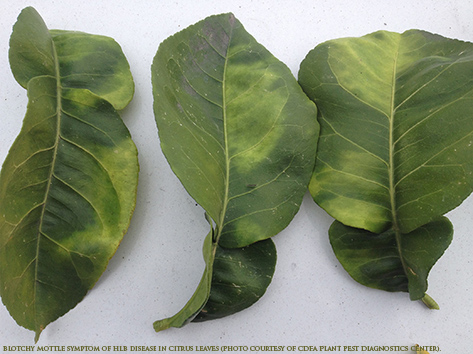Huanglongbing Pest Profile

- Common Name:
Huanglongbing pathogen,
Citrus Greening pathogen - Scientific Name:
Candidatus Liberibacter asiaticus - Common Names:
Huanglongbing (HLB), Citrus Greening, Yellow Shoot/Dragon Disease. - Type of Organism:
A phloem-inhabiting bacterium
The plant disease known as Huanglongbing (HLB) is believed to be caused by a phloem-restricted bacterium which is vectored by the Asian Citrus Psyllid. The scientific name of the bacterium is Candidatus Liberibacter asiaticus. The “Candidatus” portion of the name indicates that this organism cannot be cultured and is therefore characterized on the basis of DNA properties. Two other related forms of the bacterium are known—one of African origin and one of South American origin, both of which can be also be vectored by citrus psyllids. Candidatus Liberibacter is differentiated from other citrus-infecting bacteria by the presence of a cell wall and its location in the phloem tissue of the host’s vascular system.
The heat-sensitive African form of the pathogen, Candidatus Liberibacter africanus, has been reported from Africa and the Middle East. Candidatus Liberibacter americanus, a more heat-tolerant form, has been reported in Brazil and Florida. The Asian form, Candidatus Liberibacter asiaticus, which is also heat-tolerant, is primarily distributed in Asia but has also been reported from the Western Hemisphere in several states in the USA, the Caribbean, Mexico and Central America (USDA-APHIS-PPQ, 2006). In the USA it has been reported in Florida (2005), Louisiana (June 2008), South Carolina (2009), Texas (2012) and California (2012).
Citrus greening can be difficult to detect since the host may remain symptomless for months to years before showing symptoms of infection. The early symptom of the disease is a blotchy, yellow, asymmetric mottling of the leaves that crosses leaf veins (see photo). This leaf symptom is different from nutritional disorders which are more often vein-delimited and tend to be more symmetric in their pattern. The yellow mottling of the foliage gives rise to the development of yellow shoots on single random branches (nutritional disorders generally show more uniform symptom distribution in trees). Progressive yellowing of greater portions of the canopy follows. Huanglongbing bacteria do not cause foliar wilting such as that observed in trees infected by other citrus pathogens. More advanced symptoms include twig dieback, stunting and decline in the tree’s health to the point where the tree bears only a few, small, deformed (lop-sided) fruits that are poorly colored and bitter tasting. Tree mortality usually occurs several months to years after infection.
The HLB pathogen is moved from tree to tree by psyllids feeding on an infected tree then moving to and feeding on a non-infected tree. After gaining entrance to the tree’s vascular system by psyllid feeding, the pathogen takes up residence in the phloem tissue. As the bacterium multiplies and moves within the tree’s vascular system, it chokes off the supply of nutrients moving throughout the plant, weakening the plant and eventually killing it. While insect vectoring of the HLB pathogen is the primary means of disease spread, the movement of infected host plant material, either in the form of nursery stock or of plant tissue for grafts and buds, can also contribute significantly to the rapid and potentially long-distance spread of the disease.
Hosts for the citrus greening pathogen include nearly all citrus species and hybrids, as well as numerous citrus relatives in the Family Rutaceae. A comprehensive host list for the HLB pathogen can be found listed in the California Department of Food and Agriculture Huanglongbing Disease State Interior Quarantine #3439 (see Section C.1.) at:
Detection of the disease is extremely difficult by symptoms alone. Diagnostic laboratories utilize molecular assays to detect the DNA of the bacterium in plant hosts and in insect vectors to confirm the presence and identity of the pathogen. However, diagnostics are difficult when there are no symptoms because the pathogen population in the tree may be too low to detect. Therefore plant samples are generally collected from symptomatic foliage. Veins and petioles are cut from the leaves and processed in the laboratory to maximize the chance of detecting the bacteria.
HLB has been described as the most devastating disease of citrus in the world. HLB affects almost all citrus cultivars, and causes substantial economic and environmental losses to the citrus industry as well as back-yard citrus by shortening the life of trees and making fruit and juice inedible. In a recent study in Florida, the presence of HLB increased citrus production costs by 40 percent (Irey et al. 2008). It is estimated that over the last 5 years in Florida, HLB has caused the loss of over 6600 jobs, over $1.3 billion in lost revenue to the citrus industry, and the loss of over $3.6 billion in total economic activity (Hodges and Spreen 2012).
At present there are no curative methods to control HLB and unlike control options for the psyllid vector, there are no chemical controls that specifically target the bacterium. Thus, comprehensive control measures for HLB focus largely on prevention of infection by eradicating infected plants and citrus psyllid hosts, as well as production and planting of Huanglongbing-free trees and control of the citrus psyllid vector.
Literature Cited:
- Global Invasive Species Database, 2009. Candidatus Liberibacter asiaticus. Available from:http://www.issg.org/database/species/ecology.asp?si=1496&fr=1&sts=sss
- Hodges, A. W. and T. H. Spreen. 2012. Economic impacts of citrus greening (HLB) in Florida, 2006/07 to 2010/2011. Institute of Food and Agricultural Sciences, University of Florida. Document FE903. 5 pp. http://ufdc.ufl.edu/IR00005615/00001
- Irey, M. S., T. Gast, and J. Snively. 2008. Economic impact of managing Huanglongbing in groves at Southern Gardens citrus. I Taller Internacional sobre Huanglongbing de los cítricos (Candidatus Liberibacter spp) y el psílido asiático de los cítricos (Diaphorina citri). Hermosillo, Sonora. México 2008. 5 pp. http://www.concitver.com/huanglongbingYPsilidoAsiatico/Memor%C3%ADa-6%20Irey.pdf
- NAPPO (2011) Citrus Huanglongbing Diagnostic Protocol. Secretariat of the North American Plant Protection Organization 1431 Merivale Rd., 3rd Floor, Room 140 Ottawa, Ontario, K1A 0Y9 Canadá.
- USDA-APHIS-PPQ. 2006. New pest guidelines: Candidatus Liberibacter africanus, Ca L asiaticus, Ca L americanus. Huanglongbing. Citrus Greening Disease. USDA-APHIS-PPQ Riverdale, MD.

